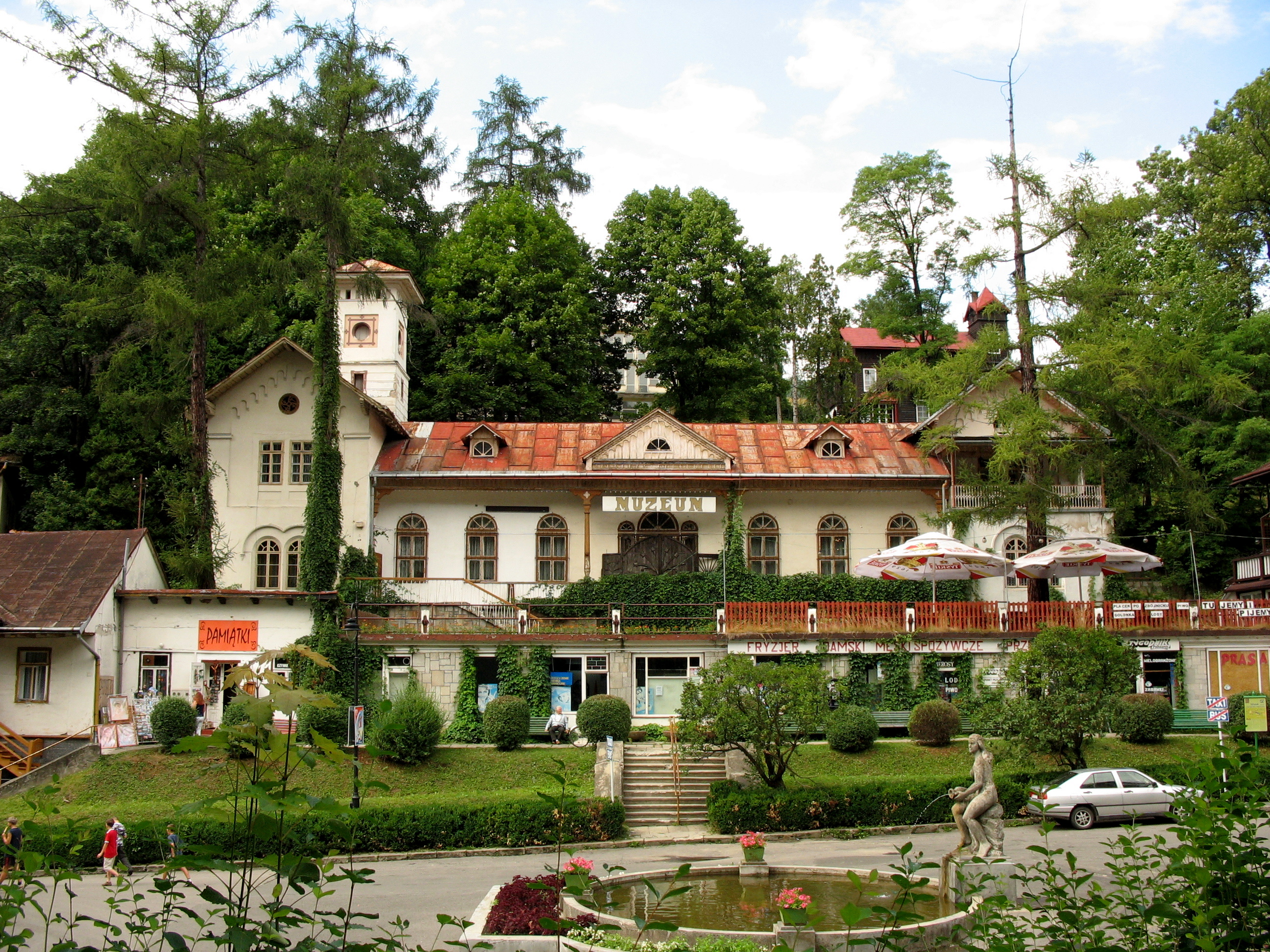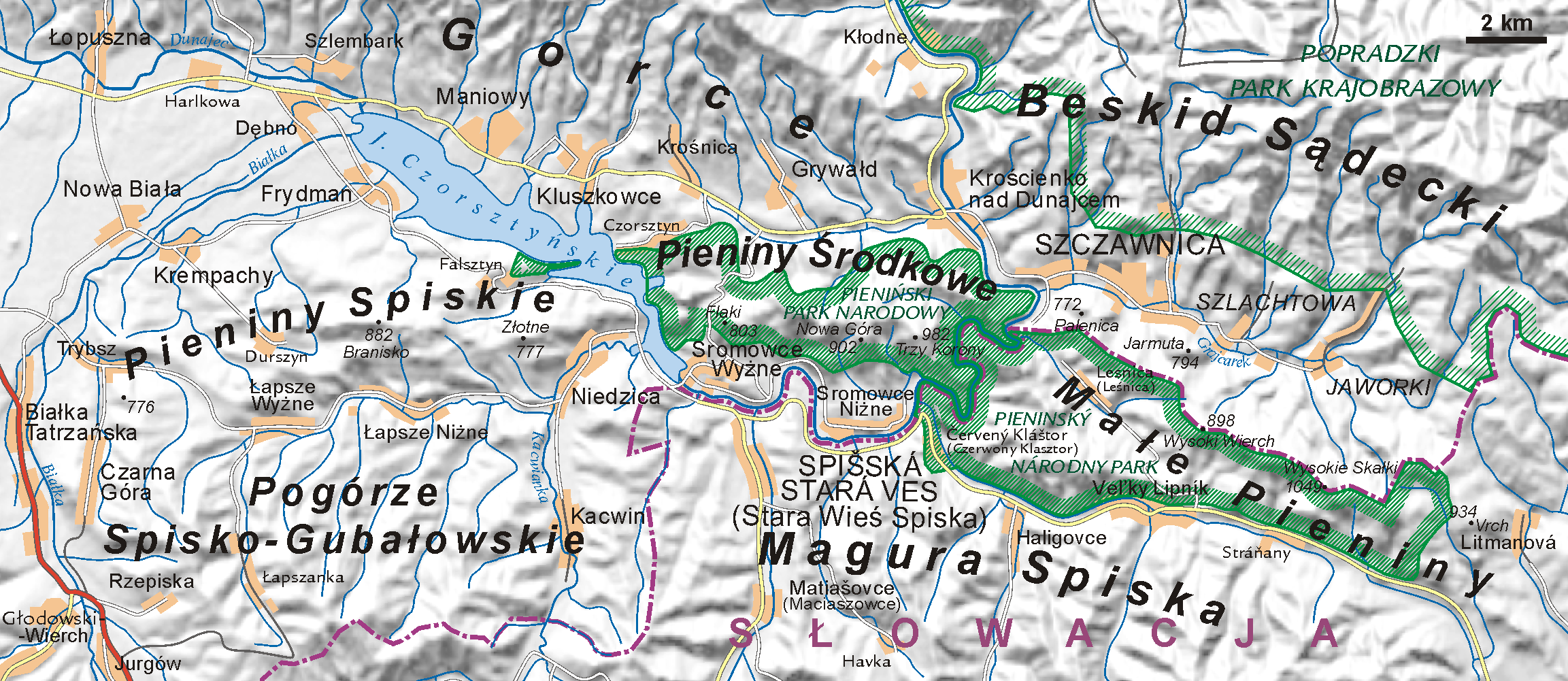|
Grajcarek
Grajcarek is a minor river, a stream, running between foothills of the Lesser Pieniny and Beskid Sądecki. It starts at Jaworki, as the confluence of the Biała Woda and Czarna Woda streams. The river flows through Jaworki, Szlachtowa, and flows into the Dunajec in Szczawnica, just before the characteristic Kotuńka Rock, at an elevation of 430 metres. After the crossroads of the roads is a bridge, under which flows the river Grajcarek, after which the Pieniny Trail Road begins. The source of Grajcarek are considered to be at the source of Biała Woda, which is found at a height of approximately 950 metres. The basin area of the river is 85,5 km², the length from the source to the mouth of the river is about 15 km, with an average fall of 3.5%. The river flows in the general direction of East to the West of the valley, which is also the border between the Pieniny and Beskid Sądecki. Formerly Grajcarek was called ''Ruski Potok'' which can be translated as Ruthenian S ... [...More Info...] [...Related Items...] OR: [Wikipedia] [Google] [Baidu] |
Beskid Sądecki
Beskid Sądecki is a mountain range in the eastern section of the Western Beskids, within the Outer Western Carpathians. It is located in the border region between Poland and Slovakia. On the Polish side, it stretches along an area of 670 km², between the Dunajec river in the west and the valleys of the Kamienica Nawojowska river, Mochnaczka, Muszynka, Przełęcz Tylicka in the east. The highest peak of the mountain range is Radziejowa at 1262 metres. The mountains are built from flysch rocks. Topography The Beskid Sądecki links with three other mountain ranges: *Jaworzyny Range *Radziejowej Range *Leluchowskie Mountains According to Slovak geographers, Beskid Sądecki is part of Ľubovnianska vrchovina. The separation of the ranges was done by Poland, during the regionalisation of mountains made by Jerzy Kondracki, which the mountain range is named by in Slovakia. Some Polish geographers state that the Slovak part of the Radziejowej Range can be linked with the ... [...More Info...] [...Related Items...] OR: [Wikipedia] [Google] [Baidu] |
Szczawnica
Szczawnica is a resort town in Nowy Targ County in Lesser Poland Voivodeship, in southern Poland. As of June 30, 2007, its population was 7,378. Szczawnica has been a well-known resort town since the mid nineteenth century. Due to the presence of alkali sorrel springs and favorable climatic conditions, many respiratory and digestive tract illnesses are treated there. In 2005 the popular local spa was officially returned by the Polish government to its prewar owners – Count Stadnicki family. The spa has almost two-hundred-year history. Its last private owner was Count Adam Stadnicki, whose grandson – Andrzej Mańkowski – is the founder of the new Spa Town Museum being fitted in the center of Szczawnica, at Dietl Square (2009). The museum of the Szczawnica resort aims to present more than 350 different types of artifacts associated with the local therapeutics, archival documents, drawings, plans of buildings, old photographs, postcards and books. Szczawnica has many skiing t ... [...More Info...] [...Related Items...] OR: [Wikipedia] [Google] [Baidu] |
Ruś Szlachtowska
Ruś Szlachtowska (''Shlakhtov Ruthenia'') was a name introduced in 1930s by Prof. Roman Reinfuss to denote the region surrounding the villages of Biała and Czarna Woda, Jaworki, and Szlachtowa in the Grajcarek valley in the Pieniny mountains, in the Nowy Targ County of southern Poland. The region was the westernmost area inhabited by Lemkos. It was separated from the rest of the Lemko Region by the Polish-dominated Poprad valley which led to isolation of the local population and its gradual assimilation with Poles and Slovaks, until Operation Vistula in 1947, when the Lemkos were deported together with Ukrainians to other areas of Poland and to the Soviet Union. Since then, the villages of Jaworki and Szlachtowa were gradually settled by Polish population from Podhale and Spisz, and the remaining two villages do not exist today. It is not known for certain when the first settlers arrived in the valley, but it was probably not before the 15th century because Jan Długosz ... [...More Info...] [...Related Items...] OR: [Wikipedia] [Google] [Baidu] |
Jaworki, Lesser Poland Voivodeship
Jaworki (Lemko: Явіркы, uk, Явірки, Yavirky) is a village in the administrative district of Gmina Szczawnica, within Nowy Targ County, Lesser Poland Voivodeship, in southern Poland. It was formerly part of the town of Szczawnica, but was made a separate village on 1 January 2008 (as was Szlachtowa). It includes the former villages of Biała Woda ("white water") and Czarna Woda ("black water"). The village used to constitute a part of Ruś Szlachtowska region, the westernmost area inhabited by Lemkos. Two other villages of this region Biała Woda and Czarna Woda Czarna Woda (; formerly german: Schwarzwasser) is a town in Starogard County, Pomeranian Voivodeship, Poland Poland, officially the Republic of Poland, is a country in Central Europe. It is divided into 16 administrative provinces ... are now part of the village Jaworki. Gallery File:Jaworki - Kosciol.jpg, Local church File:Radziejowa P16-5.jpg, Scenery File:Jaworki P2.jpg, General view ... [...More Info...] [...Related Items...] OR: [Wikipedia] [Google] [Baidu] |
Dunajec
The Dunajec (); Goral dialects: ''Dónajec'') is a river running through northeastern Slovakia and southern Poland. It is also regarded as the main river of the Goral Lands. It is a right tributary of the Vistula River. It begins in Nowy Targ at the junction of two short mountain rivers, Czarny Dunajec and Biały Dunajec (Black and White Dunajec). Dunajec forms the border between Poland and Slovakia for in the Pieniny Środkowe (Slovak: Centrálne Pieniny) range, east of the Czorsztyn reservoir. Geography The Dunajec is long, including its source river Czarny Dunajec,Statistical Yearbook of the Republic of Poland 2017 |
Poland
Poland, officially the Republic of Poland, is a country in Central Europe. It is divided into 16 administrative provinces called voivodeships, covering an area of . Poland has a population of over 38 million and is the fifth-most populous member state of the European Union. Warsaw is the nation's capital and largest metropolis. Other major cities include Kraków, Wrocław, Łódź, Poznań, Gdańsk, and Szczecin. Poland has a temperate transitional climate and its territory traverses the Central European Plain, extending from Baltic Sea in the north to Sudeten and Carpathian Mountains in the south. The longest Polish river is the Vistula, and Poland's highest point is Mount Rysy, situated in the Tatra mountain range of the Carpathians. The country is bordered by Lithuania and Russia to the northeast, Belarus and Ukraine to the east, Slovakia and the Czech Republic to the south, and Germany to the west. It also shares maritime boundaries with Denmark and Sweden. ... [...More Info...] [...Related Items...] OR: [Wikipedia] [Google] [Baidu] |
Pieniny
The Pieniny (sometimes also the PieninsSzafer, Władysław. 2013. ''The Vegetation of Poland: International Series of Monographs in Pure and Applied Biology''. Warsaw: Pergamon Press, pp. 156, 388. or the Pienin Mountains,Griffiths, Graham C. D. 1976. Studies on Boreal Agromyzidae (Diptera). XII. ''Phytomyza'' and ''Chromatomyia'' miners on Astereae (Compositae).''Quaestiones Entomologicae'' 12: 239–275, p. 255. hu, Pieninek) is a mountain range in the south of Poland and the north of Slovakia. It is classified within the eastern section of the Western Beskids. The Pieniny mountain range is divided into three parts – ''Pieniny Spiskie'' ( sk, Spišské Pieniny) and ''Pieniny Właściwe'' (Slovak: ''Centrálne Pieniny'') in Poland; and, ''Małe Pieniny'' ( en, Lesser or Little Pieniny; sk, Malé Pieniny) in Poland and Slovakia. The Pieniny mountains consist mainly of beds of limestone and dolomite. The most famous peak, ''Trzy Korony'' (Three Crowns), is 982 metres high. ... [...More Info...] [...Related Items...] OR: [Wikipedia] [Google] [Baidu] |
Confluence
In geography, a confluence (also: ''conflux'') occurs where two or more flowing bodies of water join to form a single channel. A confluence can occur in several configurations: at the point where a tributary joins a larger river (main stem); or where two streams meet to become the source of a river of a new name (such as the confluence of the Monongahela and Allegheny rivers at Pittsburgh, forming the Ohio); or where two separated channels of a river (forming a river island) rejoin at the downstream end. Scientific study of confluences Confluences are studied in a variety of sciences. Hydrology studies the characteristic flow patterns of confluences and how they give rise to patterns of erosion, bars, and scour pools. The water flows and their consequences are often studied with mathematical models. Confluences are relevant to the distribution of living organisms (i.e., ecology) as well; "the general pattern ownstream of confluencesof increasing stream flow and decreasing s ... [...More Info...] [...Related Items...] OR: [Wikipedia] [Google] [Baidu] |
Szlachtowa
Szlachtowa (Lemko: Шляхтова, uk, Шляхтова, ''Shliakhtova'') is a village in the administrative district of Gmina Szczawnica, within Nowy Targ County, Lesser Poland Voivodeship, in southern Poland. It was formerly part of the town of Szczawnica, but was made a separate village on 1 January 2008 (as was Jaworki). The village used to constitute a part of Ruś Szlachtowska region (with the name derived from Szlachtowa), the westernmost area inhabited by Lemko Lemkos ( rue, Лeмкы, translit= Lemkŷ; pl, Łemkowie; uk, Лемки, translit=Lemky) are an ethnic group inhabiting the Lemko Region ( rue, Лемковина, translit=Lemkovyna; uk, Лемківщина, translit=Lemkivshchyna) of Car ...s. References Villages in Nowy Targ County {{NowyTarg-geo-stub ... [...More Info...] [...Related Items...] OR: [Wikipedia] [Google] [Baidu] |
Latchorzew
Latchorzew is a village in the administrative district of Gmina Stare Babice, within Warsaw West County, Masovian Voivodeship, in east-central Poland. It lies approximately south of Stare Babice, north-east of Ożarów Mazowiecki (the county seat), and west of Warsaw Warsaw ( pl, Warszawa, ), officially the Capital City of Warsaw,, abbreviation: ''m.st. Warszawa'' is the capital and largest city of Poland. The metropolis stands on the River Vistula in east-central Poland, and its population is officia .... References Latchorzew {{WarsawWest-geo-stub ... [...More Info...] [...Related Items...] OR: [Wikipedia] [Google] [Baidu] |
Operation Vistula
Operation Vistula ( pl, Akcja Wisła; uk, Опера́ція «Ві́сла») was a codename for the 1947 forced resettlement of 150,000 Ukrainians (Boykos and Lemkos) from the south-eastern provinces of post-war Poland, to the Recovered Territories in the west of the country. The action was carried out by the Soviet-installed Polish communist authorities with the aim of removing material support and assistance to the Ukrainian Insurgent Army. The Ukrainian Insurgent Army continued its guerilla activities until 1947 in both Subcarpathian and Lublin Voivodeships with no hope for any peaceful resolution. Operation Vistula effectively brought an end to the hostilities. In a period of three months beginning on 28 April 1947 and with Soviet approval and aid, about 141,000 civilians residing around Bieszczady and Low Beskids were forcibly resettled to formerly German territories, ceded to Poland at the Yalta Conference at the end of World War II. The operation was named after the ... [...More Info...] [...Related Items...] OR: [Wikipedia] [Google] [Baidu] |




